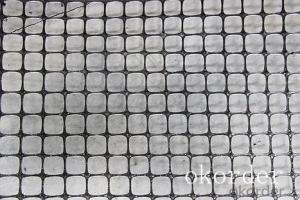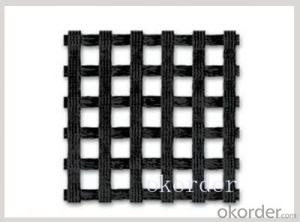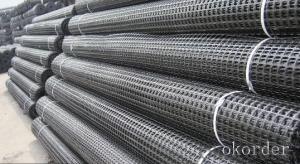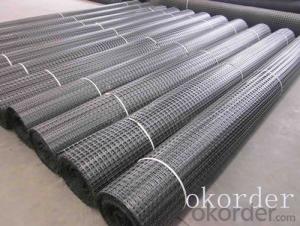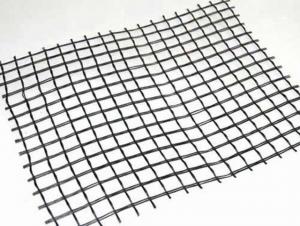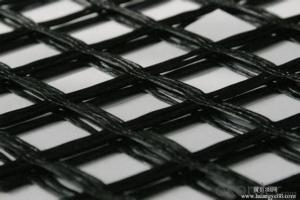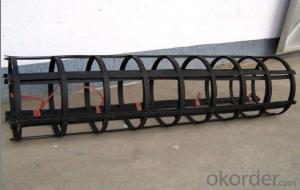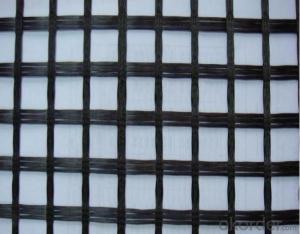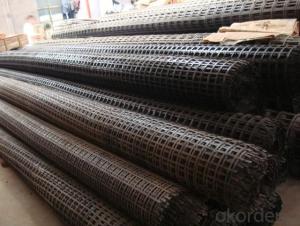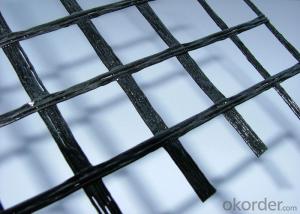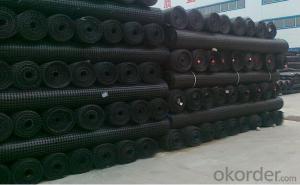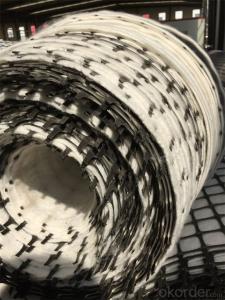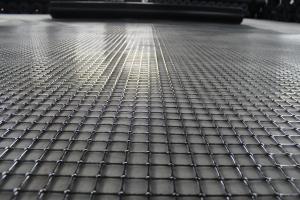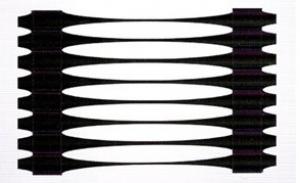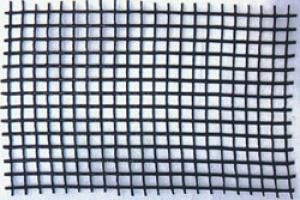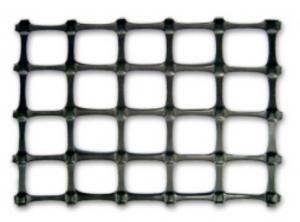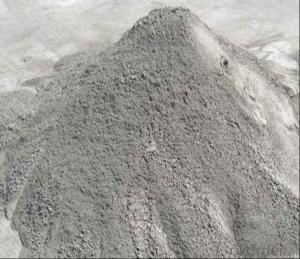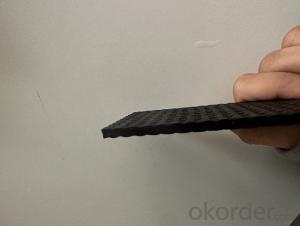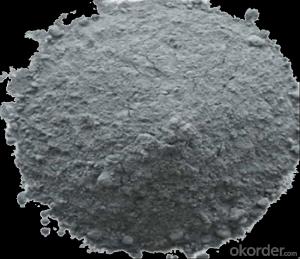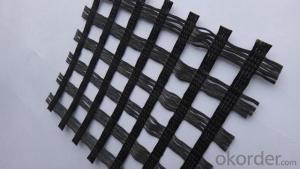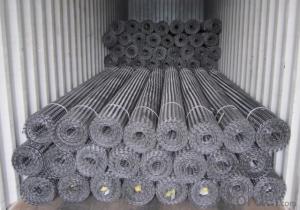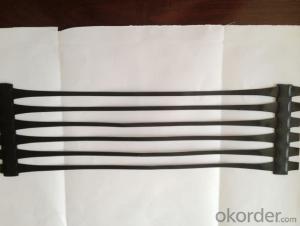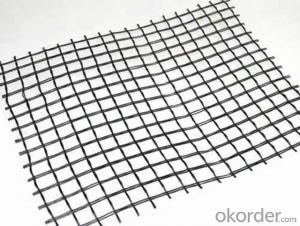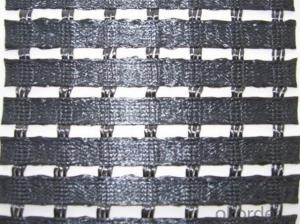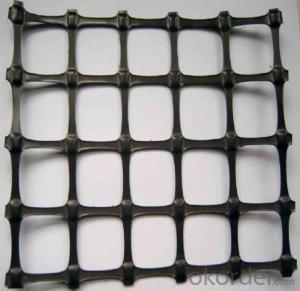High Modulus Geogrid of Civil Engineering Products in Road Construction
- Loading Port:
- China main port
- Payment Terms:
- TT OR LC
- Min Order Qty:
- 1000 m²
- Supply Capability:
- 10000000 m²/month
OKorder Service Pledge
OKorder Financial Service
You Might Also Like
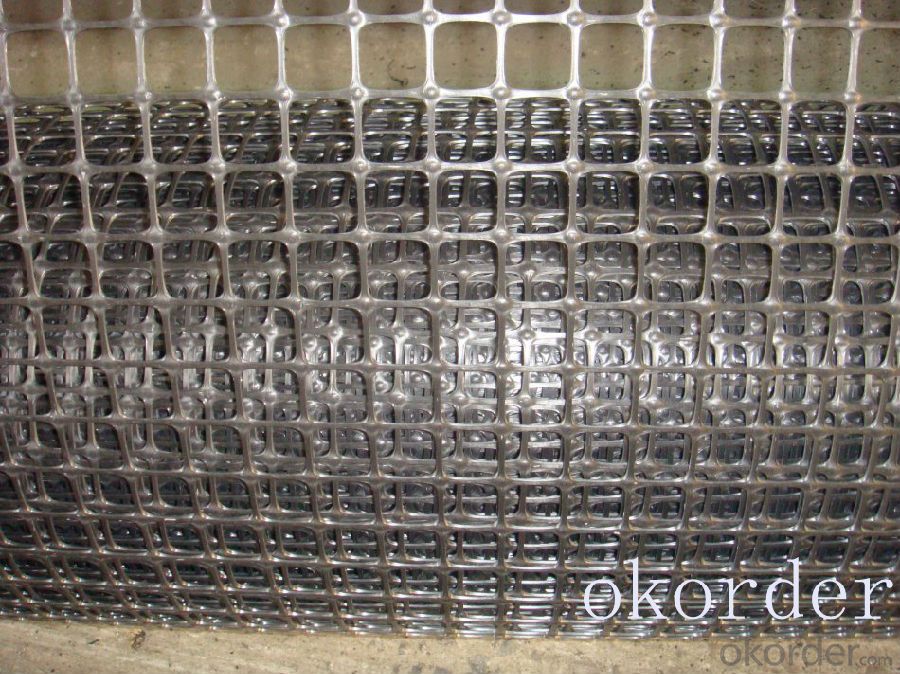
Product Introduction
A geogrid is geosynthetic material used to reinforce soils and similar materials. Geogrids are commonly used to reinforce retaining walls, as well as subbases or subsoils below roads or structures. Soils pull apart under tension. Compared to soil, geogrids are strong in tension. This fact allows them to transfer forces to a larger area of soil than would otherwise be the case.
Material:
Fiberglass
Tensile strength:
100kn
Roll Width:
3.95m
Roll length:
100 Meter
Porducts Description
Our Service
Quality assurance
1.On a regular basis or as per your request,we entrust national testing agencies to conduct quality inspections
2. Strictly in accordance with the ISO9001-2008 international quality system standard,we monitor and manage the whole process throughout production,quality testing,and measurement to ensure product quality
3. For quality-related construction delay or substandard construction(except for damage or losses due to customer’s responsibility or irresistible natural disasters),we have refunding,replacement,and repair services.We will respond to customers’ feedbacks on quality issues within 24 hours.
Packaging & Shipping
Packing: PLASTIC FILM INSIDE, AND WOVEN BAG OUTSIDE
Shipping: About 15 days after receipt the deposit
FAQ:
Q: What kind of payments does jenor support?
A: T/T, L/C, Cash are accepted.
Q: Do you charge for the samples?
A: Accordeing to our company policy, the samples are free, we only charge the freight fee. And we will return the freight fee during the next order.
Q: Can you produce according to customers' design?
A: Sure, we are professional manufacturer, OEM and ODM are both welcome.
Q: Do you have other products?
A: Yes, please check the pictures:
- Q:Can geogrids be used in reinforced concrete pavements?
- Yes, geogrids can be used in reinforced concrete pavements. Geogrids are commonly used as a reinforcement material in concrete pavements to enhance their strength, durability, and load-bearing capacity. By distributing and restraining the forces within the concrete, geogrids help to minimize cracking and improve overall pavement performance.
- Q:What are the long-term maintenance requirements for geogrids?
- The long-term maintenance requirements for geogrids are typically minimal. Once installed, geogrids require periodic inspections to ensure they are functioning properly and to address any issues that may arise, such as soil erosion or damage to the geogrid itself. Additionally, regular maintenance of the surrounding area, such as vegetation control and debris removal, can help prolong the lifespan and effectiveness of the geogrids.
- Q:What is the effect of strain rate on geogrid behavior?
- The effect of strain rate on geogrid behavior is that it can significantly impact the mechanical properties and performance of the geogrid. At higher strain rates, the geogrid may exhibit increased stiffness and strength due to the rate-dependent nature of its materials. This means that the geogrid can better resist deformations and provide enhanced stability under dynamic loading conditions. However, at extremely high strain rates, the geogrid may experience reduced performance and even failure due to excessive stress concentrations and insufficient time for dissipation of energy. Thus, understanding and considering the strain rate is crucial in designing and applying geogrids for different applications.
- Q:Can geogrids be used in reinforcement of foundation soils?
- Yes, geogrids can be used in the reinforcement of foundation soils. Geogrids are commonly used in civil engineering projects to improve the stability and strength of soil structures, including foundations. They are effective in distributing loads and reducing settlement, providing additional support to foundation soils.
- Q:How to determine geogrid reinforcement or crack resistance
- Asphalt pavement cracking is one of the most common diseases in asphalt pavement in the world. No matter in the frozen area or in the non frozen area, the crack severity is different. The causes of asphalt pavement cracking and cracks in the form of a variety, but the main reason for the cracking of asphalt pavement, cracks can be divided into two categories, namely, the type of load cracks and non load cracks.The use of geotechnical materials to prevent asphalt pavement cracking effect is obvious. Selection of good resistance to erosion, dry shrinkage, temperature shrinkage coefficient is small, high tensile strength of semi-rigid material as the base, it is best to use the low temperature expansion coefficient of aggregate.High quality asphalt with good relaxation performance is used as the surface layer to ensure the penetration and ductility of asphalt. Certain additives or polymers should be used. In order to improve the low temperature crack resistance and high temperature stability of asphalt.
- Q:What are the factors that affect the design of geogrid installations?
- There are several factors that can influence the design of geogrid installations. Firstly, the type and condition of the soil plays a crucial role as it determines the required strength and stability of the geogrid. The load that the geogrid will be subjected to is another important factor, as it dictates the necessary tensile strength and stiffness of the geogrid. Additionally, the slope and geometry of the project site need to be considered to ensure proper installation and performance of the geogrid. The climate and environmental conditions, such as temperature and moisture, can also impact the design, as they can affect the durability and long-term performance of the geogrid. Finally, the availability and cost of materials, as well as any relevant regulations or design standards, should be taken into account during the design process.
- Q:Are geogrids resistant to alkali degradation?
- Yes, geogrids are generally resistant to alkali degradation. They are designed to withstand harsh environmental conditions, including exposure to alkaline substances, without significant degradation or loss of strength.
- Q:Can geogrids be used in coastal erosion control?
- Yes, geogrids can be used in coastal erosion control. Geogrids are often employed as a reinforcement material to stabilize soil and prevent erosion in coastal areas. They can be used to strengthen slopes, retain beach or dune materials, and provide stability to coastal structures like seawalls or revetments. Geogrids are designed to withstand the harsh coastal environment and can effectively reduce the impact of wave and tidal action on the shoreline, making them a valuable tool in coastal erosion control efforts.
- Q:Can geogrids be used in ground stabilization for telecommunications infrastructure?
- Yes, geogrids can be used in ground stabilization for telecommunications infrastructure. Geogrids are commonly used to reinforce soils and provide stability to the ground, making them suitable for supporting the weight and load of telecommunications infrastructure such as towers, antennas, and cables. They help distribute the load more evenly, prevent soil erosion, and improve the overall stability and durability of the ground.
- Q:Details of fiberglass geogrid
- 1, slow down reflection crackThe reflection crack is due to the old concrete surface layer in the vicinity of the joint or crack of large displacement caused by asphalt overlay in above the stress concentration caused by it, including horizontal displacement caused by changes in temperature and humidity, and caused by the traffic load of the vertical shear displacement. The former leads to the concentrated tensile stress in the asphalt overlay above the joint or crack, while the latter makes the asphalt overlay above the joint undergo large bending stress and shear stress.Because the modulus of geogrid is very large, up to 67Gpa, as the application of hard interlayer stiffness in asphalt overlay layer, its role is to inhibit stress, strain release, and at the same time as the asphalt concrete reinforced material, improve overlay tensile and shear capacity, so as to achieve the purpose of crack reduction. Practice shows that a change in the direction of the horizontal crack corresponding energy can be moved from its starting point 0.6 meters, more than 1.5 meters width of the reinforcement material helps to ensure that the energy dissipated on both sides of the crack completely.
1. Manufacturer Overview |
|
|---|---|
| Location | |
| Year Established | |
| Annual Output Value | |
| Main Markets | |
| Company Certifications | |
2. Manufacturer Certificates |
|
|---|---|
| a) Certification Name | |
| Range | |
| Reference | |
| Validity Period | |
3. Manufacturer Capability |
|
|---|---|
| a)Trade Capacity | |
| Nearest Port | |
| Export Percentage | |
| No.of Employees in Trade Department | |
| Language Spoken: | |
| b)Factory Information | |
| Factory Size: | |
| No. of Production Lines | |
| Contract Manufacturing | |
| Product Price Range | |
Send your message to us
High Modulus Geogrid of Civil Engineering Products in Road Construction
- Loading Port:
- China main port
- Payment Terms:
- TT OR LC
- Min Order Qty:
- 1000 m²
- Supply Capability:
- 10000000 m²/month
OKorder Service Pledge
OKorder Financial Service
Similar products
New products
Hot products
Hot Searches
Related keywords
